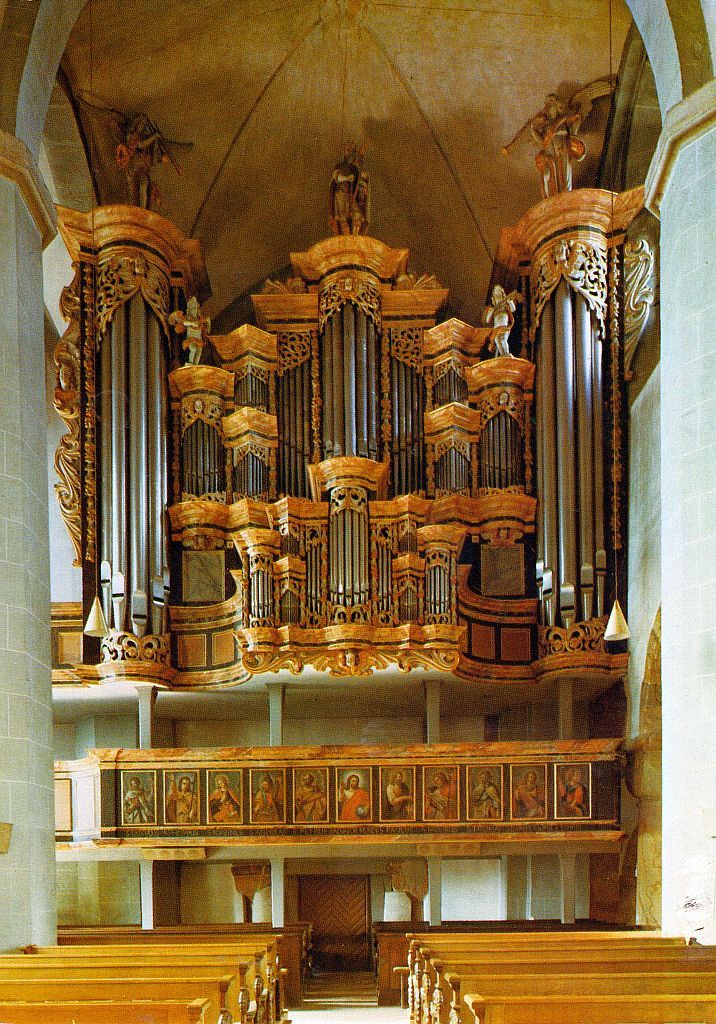Ausführliche Beschreibung der vorgewählten Orgel

Quelle: Postcard
Neuenheerse, Deutschland (Nordrhein-Westfalen) - Stiftskirche (Katholische Pfarrkirche Sankt Saturnina)
Gemeinde: Bad Driburg
Adresse: Stiftstraße 4, 33014, Neuenheerse
Website: http://www.pv-bad-driburg.de/
Beschreibung nr.: 2007695.
Gebaut von: Paul Ott (1966)
Die Orgel enthält älteren Material: Organ case aus 1713 von Andreas Reinecke
The organ of the Stiftskirche in Neuenheerse was built in old cases, supplemented with a new Rückpositiv in the old style. These cases date from 1713 and were made by Andreas Reinecke, possibly in collaboration with his brother Bernhard Reinecke. The old organ was completely rebuilt in 1882-1883. Only the cases of the main work and pedal and the prospect pipes were preserved. Franz Eggert built a new organ in these cases and removed the Rückpositiv. In 1921 this organ was made electro-pneumatic. It remained in this condition until 1964. In that year a reconstruction by Paul Ott started, which was completed in 1966. Ott also designed a new back positive in matching style. No images of the original positive were found. In the years 1991 to 1994 the organ was restored by the Kreienbrink company.
Technische Daten
Disposition
Hauptwerk (C-g'''): Quintade 16', Principal 8', Hollflöte 8', Octave 4', Spitzflöte 4', Octave 2', Sesquialtera 3 fach, Mixtur 5 fach (1 1/3'), Zimbel 3 fach (1/4'), Trompete 16', Trompete 8'.
Rückpositiv (C-g'''): Gedackt 8', Praestant 4', Blockflöte 4', Quintflöte 3', Koppelflöte 2', Terz 1 3/5', Quinte 1 1/3', Octave 1', Scharff 4 fach (1'), Dulzian 16', Schalmei 8', Tremulant.
Pedal (C-f'): Principal 16', Subbaß 16', Octave 8', Gedackt 8', Octave 4', Nachthorn 2', Bauernflöte 1', Mixtur 6 fach (2 2/3'), Posaune 16', Trompete 8'.
Koppeln: Hauptwerk - Rückpositiv, Pedal - Hauptwerk, Pedal - Rückpositiv.

Quelle: Postcard
Neuenheerse, Deutschland (Nordrhein-Westfalen) - Stiftskirche (Katholische Pfarrkirche Sankt Saturnina)
Gemeinde: Bad Driburg
Adresse: Stiftstraße 4, 33014, Neuenheerse
Website: http://www.pv-bad-driburg.de/
Beschreibung nr.: 2007695.
Gebaut von: Paul Ott (1966)
Die Orgel enthält älteren Material: Organ case aus 1713 von Andreas Reinecke
| Jahr | Orgelbauer | Opus | Aktivität | 1713 | Andreas Reinecke | Neubau | 1883 | Franz Eggert | Neubau im alten Gehäuse | 1966 | Paul Ott | Neubau im alten Gehäuse | 1994 | Kreienbrink Orgelbau | Restaurierung |
The organ of the Stiftskirche in Neuenheerse was built in old cases, supplemented with a new Rückpositiv in the old style. These cases date from 1713 and were made by Andreas Reinecke, possibly in collaboration with his brother Bernhard Reinecke. The old organ was completely rebuilt in 1882-1883. Only the cases of the main work and pedal and the prospect pipes were preserved. Franz Eggert built a new organ in these cases and removed the Rückpositiv. In 1921 this organ was made electro-pneumatic. It remained in this condition until 1964. In that year a reconstruction by Paul Ott started, which was completed in 1966. Ott also designed a new back positive in matching style. No images of the original positive were found. In the years 1991 to 1994 the organ was restored by the Kreienbrink company.
Technische Daten
| Anzahl Register pro Manual | |
| - Hauptwerk | 11 |
| - Rückpositiv | 11 |
| - Pedal | 10 |
| Gesamtzahl der Stimmen | 32 |
| Tastentraktur | Mechanical |
| Registertraktur | Mechanical |
| Windlade(n) | Slider chests |
Disposition
Hauptwerk (C-g'''): Quintade 16', Principal 8', Hollflöte 8', Octave 4', Spitzflöte 4', Octave 2', Sesquialtera 3 fach, Mixtur 5 fach (1 1/3'), Zimbel 3 fach (1/4'), Trompete 16', Trompete 8'.
Rückpositiv (C-g'''): Gedackt 8', Praestant 4', Blockflöte 4', Quintflöte 3', Koppelflöte 2', Terz 1 3/5', Quinte 1 1/3', Octave 1', Scharff 4 fach (1'), Dulzian 16', Schalmei 8', Tremulant.
Pedal (C-f'): Principal 16', Subbaß 16', Octave 8', Gedackt 8', Octave 4', Nachthorn 2', Bauernflöte 1', Mixtur 6 fach (2 2/3'), Posaune 16', Trompete 8'.
Koppeln: Hauptwerk - Rückpositiv, Pedal - Hauptwerk, Pedal - Rückpositiv.
| Literatur |
|
| Weblinks |
https://www.orgel-owl.de/n_heerse.htm http://www.pv-bad-driburg.de/Orgel.208.0.html |
